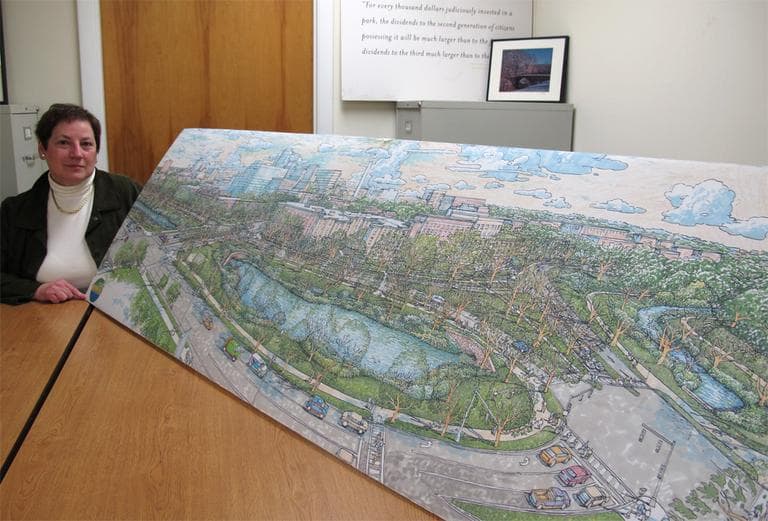Advertisement
Muddy River Restoration A Response To Climate Change
Resume
Though Boston was largely spared by Hurricane Sandy, a new study says if the storm had hit at high tide, 6 percent of the city would have been flooded.
One of the most vulnerable flood areas in the city is along the Muddy River in the Fenway. After nearly two decades of planning and negotiations, city, state and federal agencies are now beginning a project aimed at protecting the city from flooding by restoring the Muddy River to its original state.
You might be familiar with the jug handle, that traffic loop near Landmark Center in the Fenway. In the 1950s, you could look out the window of the Sears building and see the Muddy River flowing by with paths on either side. The river extended through the Fens, wrapped through Charlesgate and emptied into the Charles River. It was designed by Fredrick Law Olmsted in the late 1880s.
According to Fran Gershwin, chair of the Muddy River Restoration Project Maintenance and Management Oversight Committee, before the Charles River Dam was built, the river flowed through the entire area.
"The change occurred in the 1950s when Sears Roebuck said, 'We need more parking and unless you give us parking, Mr. Mayor, we are going to move,' " Gershwin explained. "As a result, what happened is that what was a beautiful landscape got converted to a parking lot."
The river was pushed underground through drains that weren't big enough to handle heavy rains. And that’s when the trouble began, says former Massachusetts Gov. Michael Dukakis, who grew up in Brookline, a town which was first known as the Muddy River Hamlet.
Dukakis says in 1983 it was obvious to him the river needed to be dredged, expanded and have invasive plants removed. With his staff, he drew up a plan for the restoration but he didn’t get the chance to implement it.
"Before I left office I left a plan on [former Gov. William] Weld’s desk to do precisely that," Dukakis said. "That was in 1991. He didn’t do a darn thing about it, so much so that the choking of the river led directly to this terrible flooding which took place, I can’t remember, 1995 or 1996, flooded the Green Line subway, knocked it out of action for months. It was just horrible."
The flooding caused nearly $60 million in damage. But it’s still taken 17 years to get restoration efforts underway.
The project had to navigate the interests of the federal and state governments, the city of Boston and the town of Brookline. The river is part of the national and state registries of historic places. The list of permits and documents issued is three pages long. Gershwin says the project really started moving when the federal government agreed to pick up a majority of the $92 million price tag.
"The immediate driving factor and the reason that we have the federal funding — 65 percent of the construction funding is being paid by every American citizen instead of just the citizens of Massachusetts, Brookline or Boston — and that is the storm damage reduction, which is one of the major goals of the project," Gershwin said.
Rising sea levels don’t affect the Muddy River because it’s behind the Charles River Dam. But more severe storms do pose a flooding threat. For this reason, Congress approved the money and assigned the U.S. Army Corps of Engineers to run the project.
"It’s something that has a lot of benefits, flood risk management is kind of the hook the corps is getting involved in and what brings us into the project," said Mike Keegan, the project manager. "But it has a environmental restoration benefit. It also restores Olmsted’s waterway which was somewhat lost in some sections. This would bring it back to the way Olmsted had it when he finished the project in the late 1800s."
In phase one, the corps will remove 200 trees in preparation for dredging the river and realigning traffic. This upsets some people who believe the restoration will hurt the river habitat more than it will help.
Hilary Johansen is one of the founders of the Save the Muddy River Collegiate Alliance. She says the corps is cutting down valuable trees.
"There are a few trees that are very, very large and very, very old oak trees, and it just seems to me that at least those should be allowed to stay," Johansen said.
The corps says it’s looking at what fits best with the landscape and they are replanting as many trees as they can. The long delays in the Muddy River restoration are a cautionary tale as cities such as Boston consider large-scale changes to prepare for global warming.
This program aired on February 7, 2013.